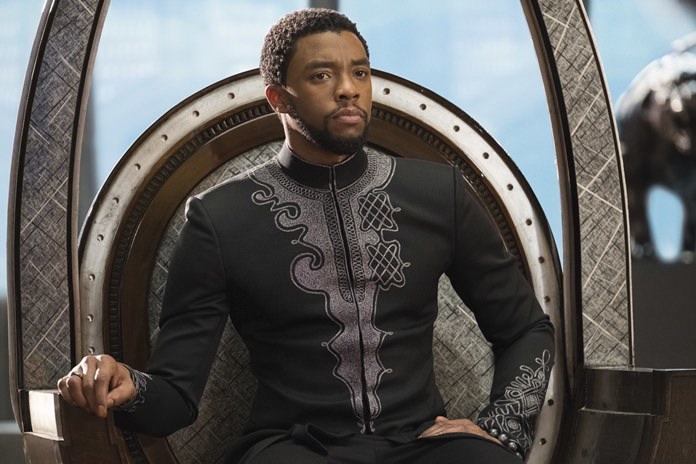
New York (AP) – The supposedly cosmically vast Marvel Cinematic Universe, as it’s called, spans planets peppered throughout the galaxy, but Ryan Coogler’s Earth-bound “Black Panther,” glittering and galvanizing, stands worlds apart.
 For those of us who have sometimes felt pummeled by the parade of previous Marvel movies, the sheer richness of Coogler’s film is almost disorienting. Can superhero films, so often a dull mash of effects, be this dazzlingly colorful? Are genuine cultural connections allowed in modern-day comic book blockbuster-making? Is a $20 billion refund in order?
For those of us who have sometimes felt pummeled by the parade of previous Marvel movies, the sheer richness of Coogler’s film is almost disorienting. Can superhero films, so often a dull mash of effects, be this dazzlingly colorful? Are genuine cultural connections allowed in modern-day comic book blockbuster-making? Is a $20 billion refund in order?
Unlike many of its more hollow predecessors, “Black Panther” has real, honest-to-goodness stakes. As the most earnest and big-budget attempt yet of a black superhero film, “Black Panther” is assured of being an overdue cinematic landmark. But it’s also simply ravishing, grand-scale filmmaking.
There are familiar Marvel beats here. Just as he did in the surprisingly sensational Rocky reboot “Creed,” Coogler hasn’t reinvented the genre so much as electrified it with a new perspective and a rare talent for marrying naturalistic character development with spectacle muscle.
“Tell them who you are” is the encouragement shouted at the title character, T’Challa (Chadwick Boseman) prince of the African nation Wakanda. But it could just as well serve as the overarching rally cry of a film that for many symbolizes a big-screen affirmation of African-American identity. “Black Panther” stands for everything that’s been missing from Marvel’s — and Hollywood’s — universe.
Coogler opens with exposition on Wakanda, a mighty African country that appears from the outside, as one Westerner sneers, as “Third World.” But hidden from sight is a shimmering, technologically advanced metropolis whose stealthy growth has been fueled by vibranium, a cosmic mineral deposited deep in its mountains by a meteorite thousands of years earlier. Vibranium makes up the suit that T’Challa dons as Black Panther, and its power is much guarded. An early flashback, to 1992 Oakland, California, shows one Wakandan’s failed efforts to smuggle Vibranium in order to empower struggling African-Americans.
When the king of Wakanda dies, T’Challa returns home to take the throne, where he finds the country’s five tribes — each with their own distinct color and attire — are beginning to bubble with discord. W’Kabi (Daniel Kaluuya) of the Border Tribe, in particular, would like to see the historically isolationist Wakanda give more in foreign aid and to refugees.
The issue is brought to the fore by an unknown Wakandan exile, Erik “Killmonger” Stevens (Michael B. Jordan), an American-made soldier who aspires to take Wakanda’s power to rebalance black power around the globe. “The world’s gonna start over and this time we’re on top,” he vows in the film’s climactic moments.
But his mission isn’t initially so clear, as he and a band of rogues, led by Andy Serkis’ black-market arms dealer Ulysses Klaue, begin causing havoc for T’Challa. Boseman’s Panther is a politician at heart who’s virtually always flanked by a trio of powerful women: Lupita Nyong’o’s Nakia, part of Wakanda’s all-female special forces, the Dora Milaje; the special forces leader Okoye (Danai Gurira); and his younger sister Shuri (a terrific Letitia Wright, who supplies most of the film’s comic moments).
There are the expected special effects set-pieces and a very Bond-like trip to a South Korean casino. But the conflict at the heart of “Black Panther” is between separate factions of an African diaspora in a mythological realm filled with colonizers and racists who curse the Wakandan as “savages.” It’s powerful myth-making not just for its obvious timeliness but for the film’s sincere grappling with heritage and destiny.
The traditional-meets-futuristic costumes and jewelry, by Ruth E. Carter, are ravishingly detailed. T’Challa’s mystical visit to his ancestors is gloriously rendered on a twilight plain beneath a pink-hued sky and the glowing eyes of panthers in a tree. And most of all, Jordan’s bitter, wounded warrior is uncommonly tender. He is a “villain” only in quotes; his means are extreme but his cause is just.
Created by Stan Lee and Jack Kirby, Black Panther first appeared in 1966. But the character has sparked the imaginations of many since, including the filmmaker Reginald Hudlin, the author Ta-Nehisi Coates and Wesley Snipes, who labored for years to adapt the comic into a movie. (Ironically it was Snipes’ 1998 superhero film “Blade” that kicked off Marvel’s box-office success.)
It’s easy to lament how long it took to bring “Black Panther” to the big screen. But at least the wait was worth it.
“Black Panther,” a Walt Disney Co. release, is rated PG-13 by the Motion Picture Association of America for “prolonged sequences of action violence, and a brief rude gesture.” Running time: 134 minutes. Three and a half stars out of four.





